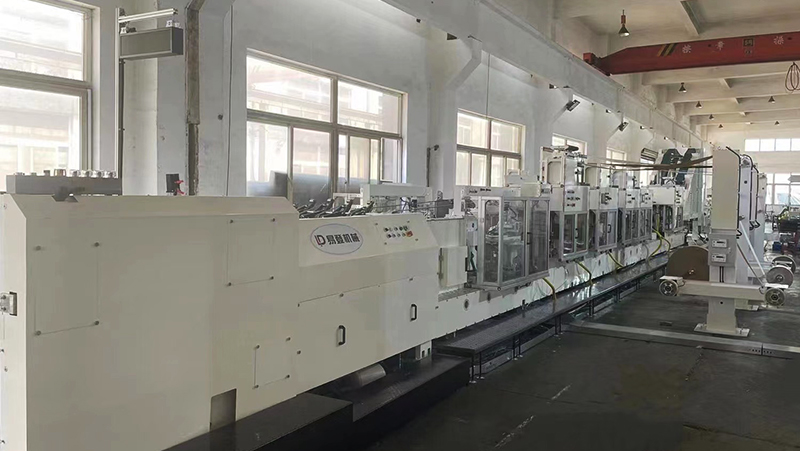Top Paper Bag Machine Solutions for Small Businesses: Efficiency Meets Affordability
Release time:2025-05-19 Classification:Knowledge
For small businesses entering the packaging industry or aiming to enhance their in-house production capabilities, investing in a reliable paper bag machine is a strategic move. These machines not only streamline operations but also align with growing consumer demand for sustainable packaging solutions. Below, we explore the critical features, benefits, and considerations for selecting the best paper bag machine tailored to small-scale operations.

Key Features of an Ideal Paper Bag Machine
- Automation and Speed
Modern paper bag machines prioritize automation to minimize manual intervention while maximizing output. Advanced models incorporate programmable controls for adjusting bag dimensions, handle types, and sealing methods. High-speed machines can produce hundreds of bags per hour, ensuring small businesses meet fluctuating demands without compromising quality. - Compact and Space-Saving Design
Space constraints are common in small facilities. Opt for machines with modular or vertical designs that occupy minimal floor space while maintaining robust production capacity. Some models integrate seamlessly into existing production lines, offering flexibility for future expansions. - User-Friendly Operation
Intuitive interfaces and simplified workflows reduce training time for operators. Look for machines with touchscreen controls, preset configurations, and real-time monitoring systems to troubleshoot issues swiftly. Safety features like emergency stops and automatic jam detection further enhance operational reliability. - Material Compatibility
The best machines accommodate a range of paper types, including recycled, kraft, and laminated varieties. Adjustable tension controls ensure consistent bag quality, whether producing lightweight retail bags or heavy-duty grocery sacks. Compatibility with biodegradable coatings or adhesives also supports eco-friendly initiatives. - Cost-Effective Maintenance
Machines with fewer mechanical components and accessible parts reduce downtime and repair costs. Features like self-lubricating systems and durable cutting blades extend lifespan, while standardized consumables (e.g., glue cartridges) ensure easy replacements.
Advantages of In-House Paper Bag Production
- Reduced Operational Costs: Eliminate reliance on third-party suppliers and lower per-unit costs through bulk material purchases.
- Customization: Tailor bag sizes, prints, and handles to align with branding or client specifications, enhancing market competitiveness.
- Sustainability: Use recyclable or FSC-certified papers to meet regulatory requirements and appeal to eco-conscious consumers.
- Scalability: Start with semi-automatic models and upgrade to fully automated systems as demand grows.
Choosing the Right Machine: A Step-by-Step Guide
- Assess Production Needs
Determine daily output targets, bag dimensions, and handle types (e.g., twisted, flat, or ribbon handles). Machines offering quick-change tooling adapt to diverse orders without recalibration delays. - Evaluate Energy Efficiency
Energy-saving motors and optimized power consumption reduce long-term operational expenses. Machines with idle-mode automation further minimize electricity usage during downtime. - Prioritize After-Sales Support
Select suppliers offering comprehensive warranties, technical assistance, and readily available spare parts. Remote diagnostics and on-site training programs ensure uninterrupted operations. - Test Material Compatibility
Request samples to verify paper thickness and adhesive performance under real-world conditions. Machines with adjustable sealing temperatures prevent material waste due to improper bonding.
Future-Proofing Your Investment
Emerging trends like smart packaging and IoT integration are reshaping the industry. Opt for machines compatible with Industry 4.0 upgrades, such as data analytics for predictive maintenance or cloud-based production tracking. Modular designs allow for retrofitting new features, ensuring your equipment remains competitive amid evolving market demands.
Investing in a high-quality paper bag machine empowers small businesses to balance cost efficiency with sustainability. By prioritizing automation, flexibility, and durability, companies can streamline production, reduce environmental impact, and scale operations seamlessly. As consumer preferences shift toward eco-friendly solutions, in-house paper bag manufacturing positions small enterprises as agile, forward-thinking players in the packaging sector.
For further details on machine specifications or customization options, explore industry-leading suppliers that align with your operational goals and sustainability commitments.






